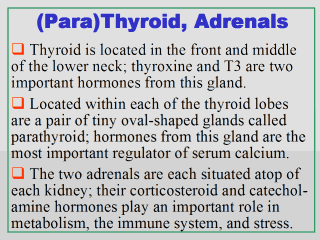| front |1 |2 |3 |4 |5 |6 |7 |8 |9 |10 |11 |12 |13 |14 |15 |16 |17 |18 |19 |20 |review |
 |
The thyroid
gland is located in the front and middle of the lower neck, below the
larynx. It is shaped like a bow tie with two halves (lobes). Tetraiodothyronine
(T4, or better known as thyroxine) and triiodothyronine (T3) are two
major hormones of the thyroid gland. These two iodine-containing peptides
control the rate at which cells burn body fuels from food to produce energy.
Other thyroid hormones, such as calcitonin, also play a key role in
bone growth and in the development of the brain and nervous system in
children. In short, thyroid hormones are vital to many body functions,
including heat production, heart rate, respiratory rate, and digestion. The
release of thyroid hormones is controlled by the pituitary gland’s
thyroid-stimulating hormone. Located within each of the thyroid lobes are (usually) a pair of tiny oval-shaped glands that function together called the parathyroid glands. With the aid of calcitonin secreted by the thyroid, the parathyroid hormone secreted by these parathyroid glands is the most important endocrine regulator of calcium levels in the blood and in the extracellular fluid. The two adrenal glands are triangular in shape, with each situated atop of each kidney. Each adrenal gland’s outer part is called adrenal cortex whereas its inner part, adrenal medulla. The adrenal cortex produces the corticosteroid hormones, which play an important role in metabolism, the immune system, certain aspects of behavior, and sexual function. These corticosteroids include aldosterone, hydrocortisone, and adrenal androgens. The adrenal medulla secretes norepinephrine and epinephrine to aid the body in dealing with stress. Both of these catecholamine hormones are associated with higher blood pressure and heart rate. |